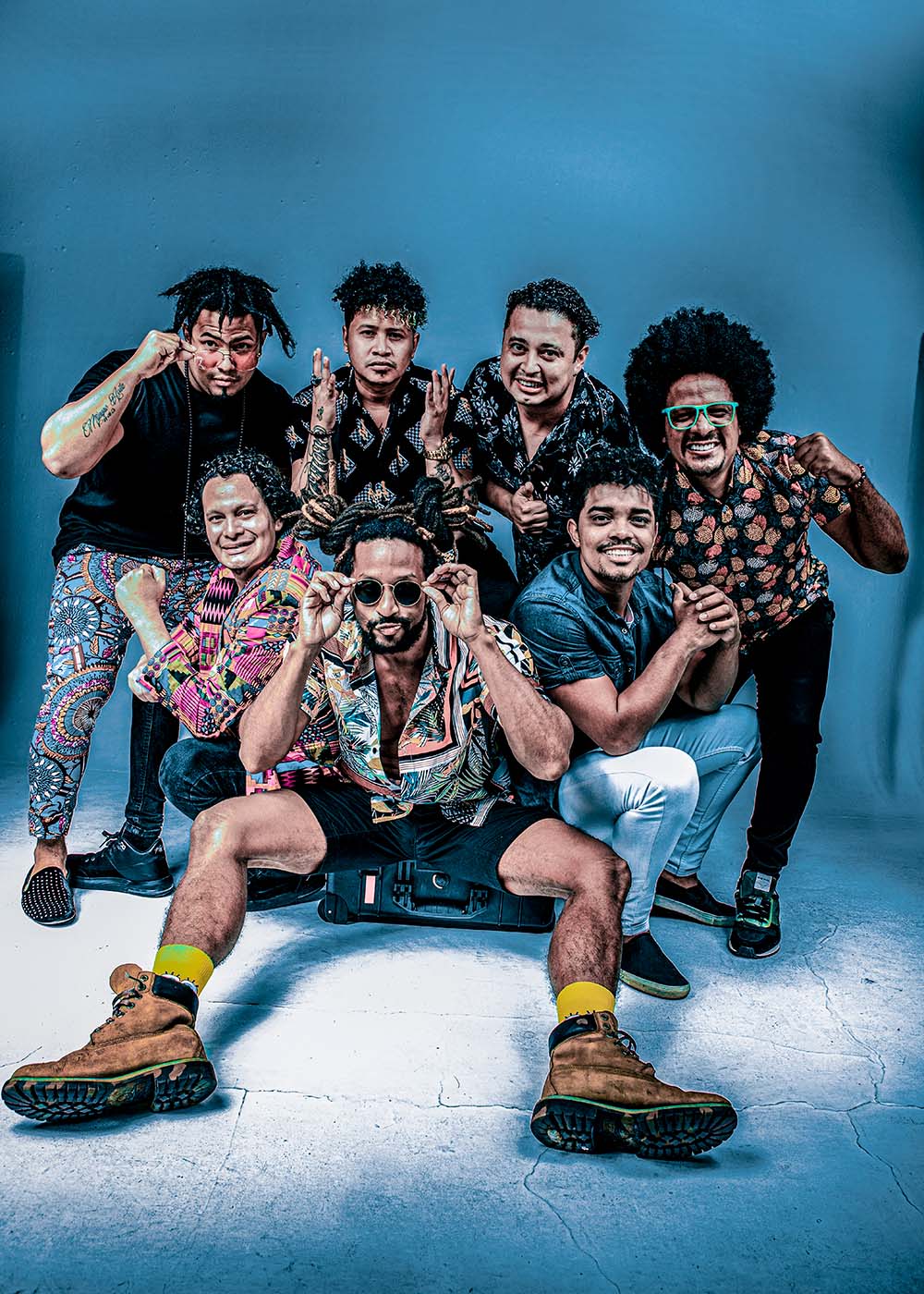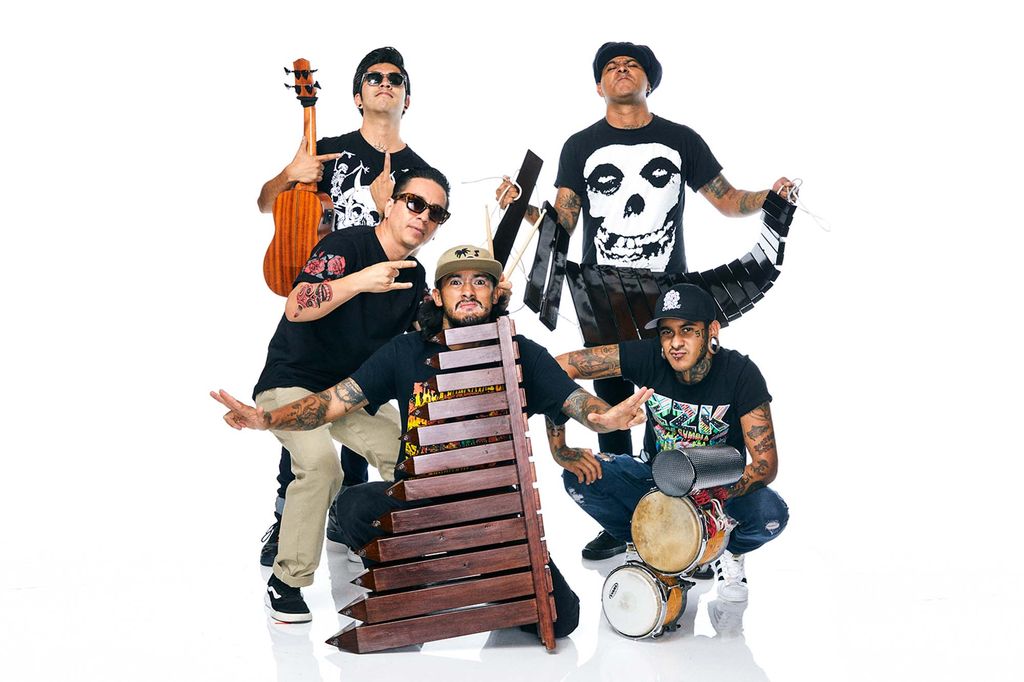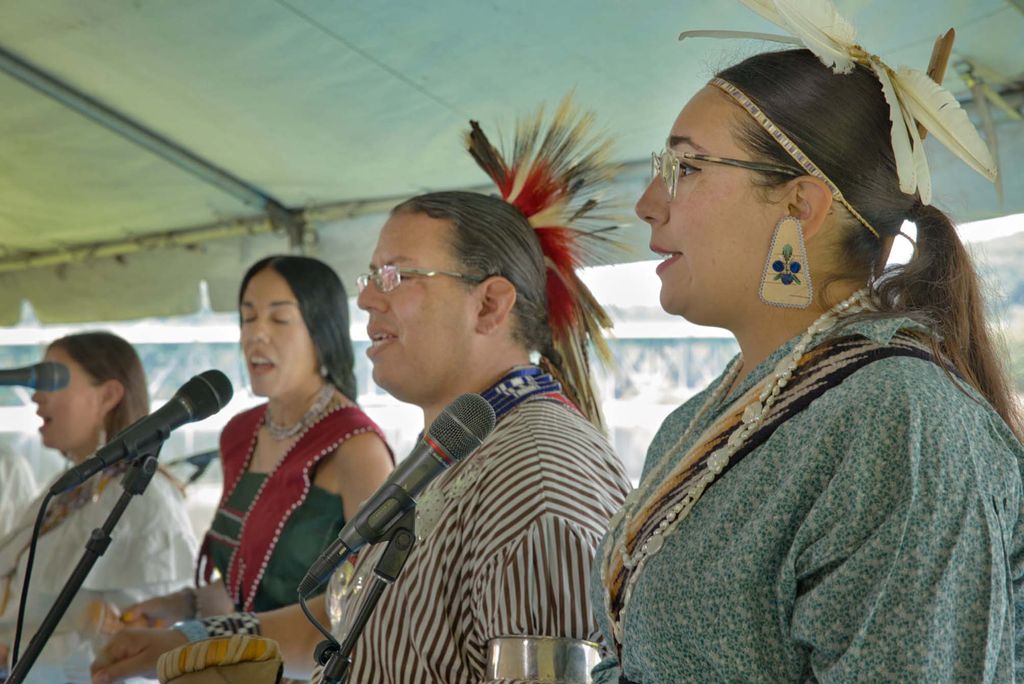Get Ready to Dance at BU’s Annual Global Music Festival

The Bazurto All-Stars. Photos courtesy of BU Global Music Festival
Get Ready to Dance at BU’s Annual Global Music Festival
Saturday’s free outdoor concert taps indigenous acts from all over
The fifth annual BU Global Music Festival, set for Saturday, September 17, features wildly different performers, from the can’t-stop-the-rhythm champeta of the Bazurto All-Stars of Bogota, Colombia, to the Native American songs of the local Kingfisher Singers and Dancers.
“We have a few high-energy powerhouses that can really throw down the party,” says artistic director Marié Abe, along with folkloric artists who explore their traditional cultures and some who infuse new sounds into the old.
Abe, a College of Fine Arts associate professor of music, musicology, and ethnomusicology, says those powerhouses are led by the fest’s closing act, the Bazurto All-Stars, three-time winners of one of the largest carnivals in Latin America. Their 8:30 pm set is one not to miss.
“It is part of our job to make people dance,” says lead singer Fredy Harel. “Even if the songs are sad songs, they still have a danceable vibe.”
The Bazurto All-Stars and most of the other acts are making their Boston debut at the free festival, which runs from noon to 9:20 pm, is open to the public, and is free for all ages. Just register here or when you arrive. The event is being held on the Warren Alpert Mall (aka BU Beach), the large open space behind Marsh Chapel (rain location: Tsai Performance Center). Several of the groups will also host workshops. The music is accompanied by a global bazaar featuring artwork, clothing, and other items, as well as food and drink (no alcohol).
Champeta is a musical style, Harel says, but more than that, “it’s a vibe, a cultural movement” that started among the Afro-Colombian population in Cartagena, Colombia.
The word originally meant a certain kind of big knife, and eventually “champetuo” came to mean a person of no class, aimed at Black Colombians, descendants of enslaved Africans, by the more prosperous Hispanic population. It is a dynamic of race and class that Harel compares to similar movements in Jamaica and Brazil, among others, that also produced unique art and culture.
“Champeta is basically a mixture of different genres generated here in the Caribbean that we inherited from the Africans who came here,” Harel says. It includes reggae, dancehall, soca, and especially, genres from the Congo. Much of it arrived first in Cartagena, which is a major international port; not coincidentally, many of those songs were heard first by the people who used those big knives in markets where imported goods were for sale. Champeta fills the air in Bazurto, the city’s public market area.
Over decades, at open-air parties and carnivals, the styles braided and mutated until arriving at its current form, where songs end with an extended section called el despeluque (meaning the chaos, or the mess, in English) when the beat gets heavier and takes over.
“Every champeta has two parts, the beginning with the melodic part and the chorus, and then el despeluque, when everybody dances and the singer kind of starts rapping,” Harel says. “Every champeta has to have these two things. If it doesn’t have them, it’s not a champeta.” In recent years, it has evolved into champeta urbana, leaning even more toward electronic beats and urban sounds.
Champeta comes with a distinct way of talking, walking, dancing, and expressing yourself and its own slang, he says, as well as its own style of music. “A lot of people would not think champeta is political, but I do see it as a political thing. I see it as a way of resistance and resilience from the Black population. A few years ago people tried to ban champeta from the radio and public events,” Harel says.
“Nowadays champeta has started becoming a trendy thing. It’s nice to be a champetuo now, and you see people coming from rich neighborhoods enjoying champeta,” he says. “It’s a good thing that champeta is getting into those spaces that it didn’t use to. But at the same time, it’s conflicted. Now it’s a good thing because it’s a trendy thing, when before it was not a good thing because it was related to Black and poor people. It’s kind of a double standard. But we are making our progress.”
Besides the Bazurto All-Stars—who perform original songs as well as a champeta-ized cover of Paul Simon’s “I Know What I Know”—the high-energy acts include Son Rompe Pera, from Mexico, led by the Gama brothers, and the duo Madalitso, from Malawi.

Son Rompe Pera “blend a very masculine punk power with marimba music, which is not what most people know about Mexican music,” Abe says. “It’s always good for people to have their assumptions challenged about what music from a particular place sounds like.
“We try to represent a wide spectrum of approaches of global music artists we bring in,” she says. “We don’t want people to think that world music is all traditional, folkloric music. A lot of people mix/infuse/experiment with music of their own heritage. Some grew up with it and some of them came to their music later. [Son Rompe Pera] grew up as punk kids and then realized, we have this amazing music, marimba music.”
Madalitso, a pair of street musicians from Malawi, uses homemade acoustic instruments, in part because they don’t always have access to electricity, “but they get people dancing!” Abe says.
The festival is also rich in traditional, vernacular music, including the work of the Saung Budaya Dance troupe, offering choreographed performances rooted from different islands in the Indonesian archipelago, and the Yamma Ensemble from Israel, presenting original Hebrew music from the Jewish diaspora across the the Mediterranean and the Middle East.

And there’s one group of performers with deep roots locally, the Kingfisher Singers and Dancers, Native Americans from the Aquinnah, Mashpee, and Herring Pond Wampanoag communities, living in Massachusetts and Rhode Island. The fest had another Native American group in previous years, and their presence is a sort of de facto land acknowledgment—“it makes sense for that to be done by the stewards of the land themselves,” Abe says.
And, she says, having a local group perform is not a contradiction for a festival that bills itself as global.
“It’s part of our mission statement to challenge the assumption that global means abroad or international,” Abe says. “Global to me is about the dynamics and the interrelationships between different places on the globe—and Boston is a global city, right? It’s about these dynamic relationships and histories.”
“It’s really important to have authentic representation by tribal members of authentic culture,” Elizabeth Perry, a member of the Aquinnah Wampanoag, says of Kingfisher. “Education is really important, because I don’t think Northeastern native people have a particularly high profile in the region.”
Perry has been involved with her tribe all her life, and grew up surrounded by friends and family who are tribal members as well. “I have been a tribal cultural educator—a tribal artist and speaker and performer—for the majority of my life,” she says. “So for decades I’ve been active in the New England area, and these are the lands that I know and the waters that I care about.”
Kingfisher will sing at the fest and may dance as well, depending on logistics. Many of their songs embody the basic Native American tenet of being part of nature.
“There are songs honoring the robin in the springtime, and the dance moves actually imitate the bird,” Perry says. “All of them have elements that are basically expressing connection and acknowledging the importance of the rest of creation and reverence for life, and of giving back through the gift of your voice, the gift of song.”

Perry’s artwork has been displayed in the George Sherman Union as well as places like the Fruitlands Museum and the Peabody Essex Museum. Through her visual art and her music, she is aiming for understanding.
“If my artwork can be positioned so that people stop and look and read, and then look out a nearby window, they can start making connections, connect to the land and make connections to native people,” Perry says. “Anything that potentially starts a meaningful dialogue and that empowers individuals to think about how they can take care of their little square of earth, I think that that’s a positive. I think it’s the opposite of erasure and dehumanizing and minimizing and overwhelming.”
The traditional songs Kingfisher will sing are as relevant today as they were hundreds of years ago, she says, and “there are new songs being written all the time and performed as well. We’re part of a living, breathing, growing culture. Having a chance to share your culture with other people piques curiosity, shows creativity, shows commonality. Everybody has music. Everybody has dance. We’re all human beings.”
Between the high-energy acts and the more traditional music, Abe says, is Qwanqwa, a supergroup of Ethiopian musicians blending vernacular styles with modern sounds, and the quirky pop duo Puuluup from Estonia, who play traditional instruments “but they’re updating it with a lot of pedals and loopers, and they’re quirky as hell and they’re fun.”
The festival is produced by the BU Arts Initiative and the College of Fine Arts School of Music musicology and ethnomusicology department, with additional support from several other BU departments and programs.
This year the festival has also doubled the number of artist workshops, to four, Abe says, “so there’s more chance for the audience to go talk to them and touch their instruments if they let you and ask questions about the music. It’s a good chance to get curious about places you’ve only read about or seen on the map, and interact with the musicians directly.”
Comments & Discussion
Boston University moderates comments to facilitate an informed, substantive, civil conversation. Abusive, profane, self-promotional, misleading, incoherent or off-topic comments will be rejected. Moderators are staffed during regular business hours (EST) and can only accept comments written in English. Statistics or facts must include a citation or a link to the citation.